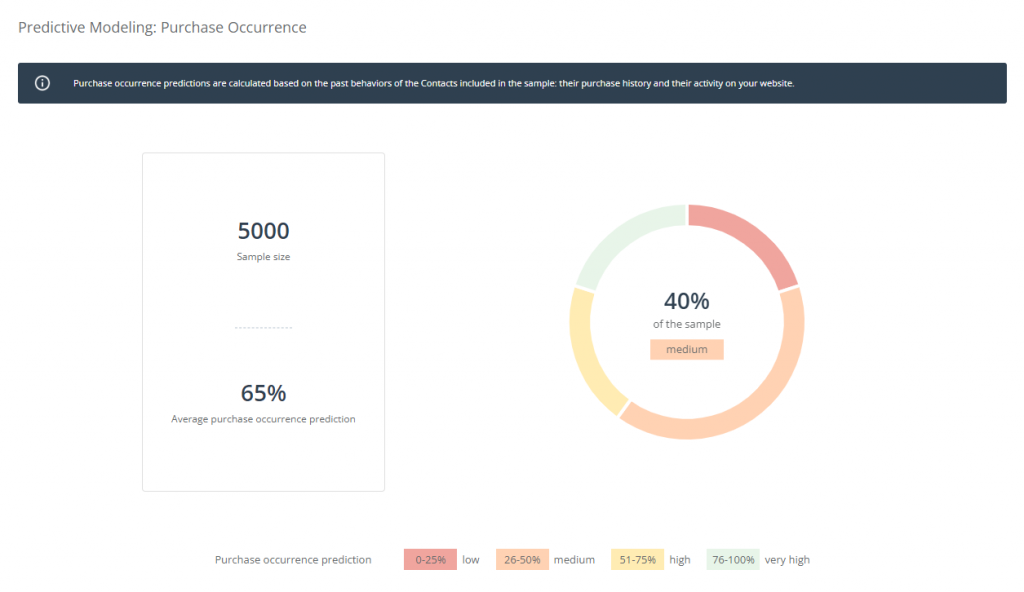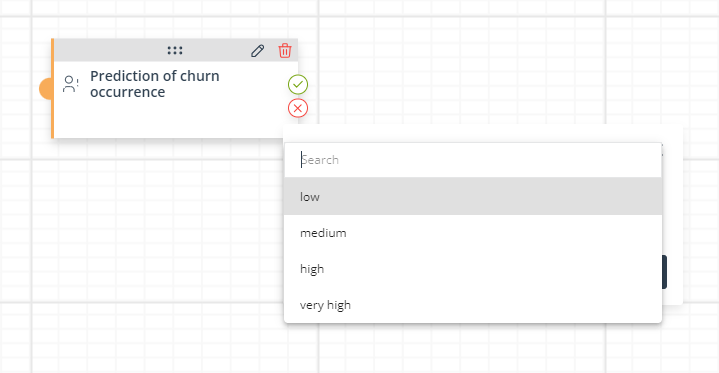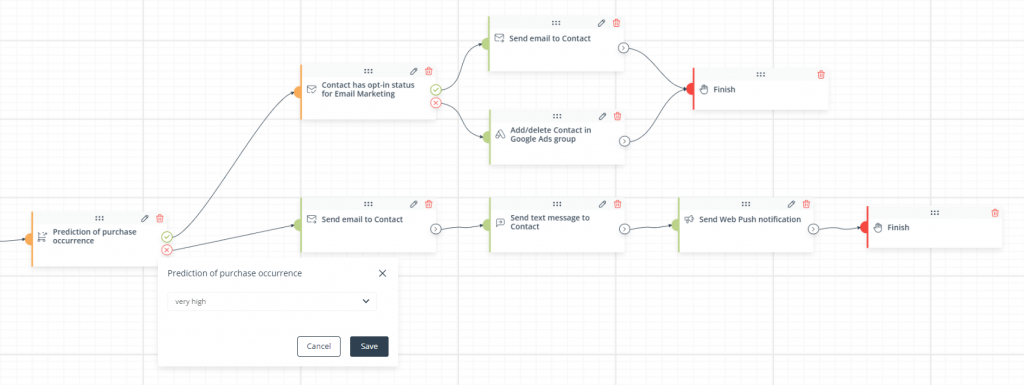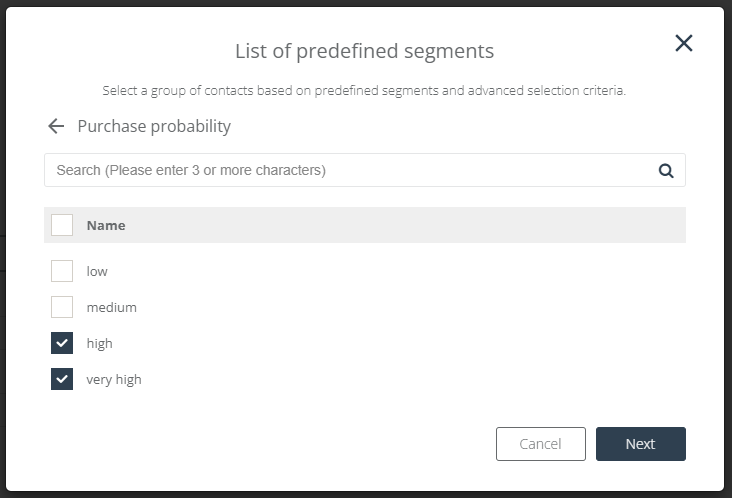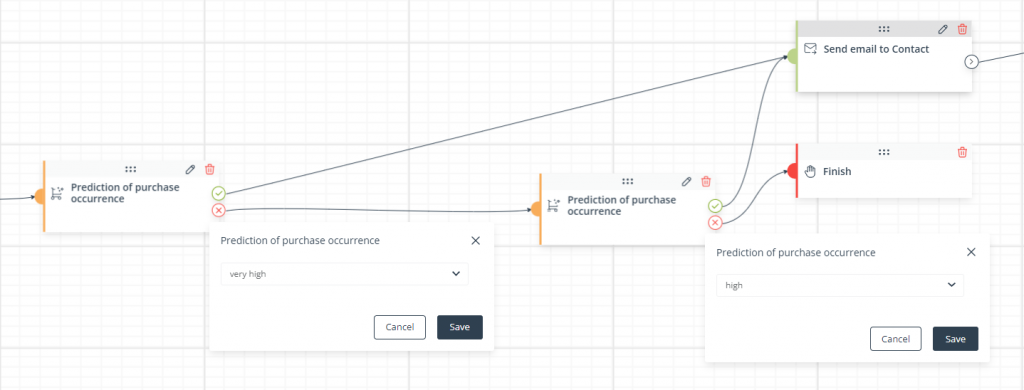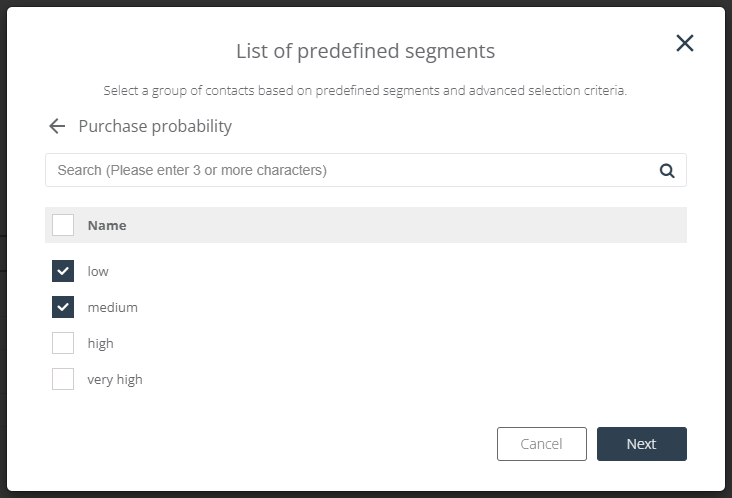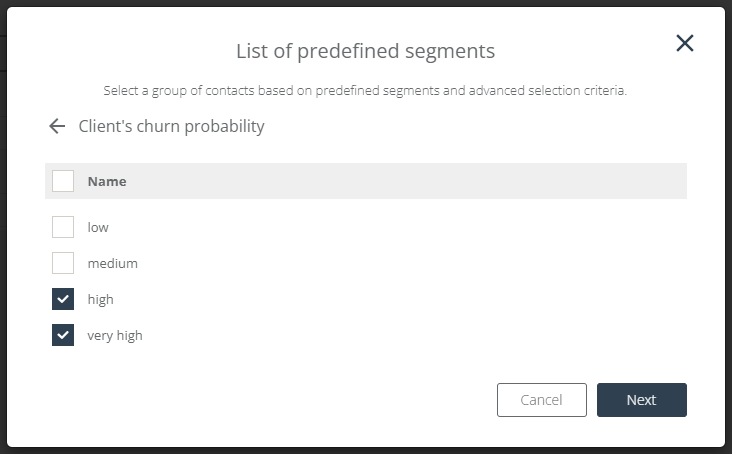Useful links
Predictive analytics is a branch of data analytics that uses historical data, statistical algorithms, and machine learning (including AI) technology to make predictions about future events or outcomes. It involves analyzing patterns and trends in existing data to forecast future behaviors. In the context of an eCommerce business, predictive analytics can be highly valuable in several ways.
This article describes the capabilities of the SALESmanago platform in the area of predictive analytics and explains how you can use these capabilities to reduce your costs, improve your marketing efficiency, strengthen your customer relationships, and ultimately increase your profits.
Contents
1. Predictive analytics in SALESmanago
The Predictive Analytics features offered by SALESmanago utilize historical data and AI models to deliver reliable predictions concerning future trends in your revenue and customer retention, but also future behaviors of individual Contacts. By applying such forecasts to your marketing strategy (by using dedicated Contact selectors or Workflow Conditions), you can improve customer experience, save money, and add to the general profitability of your business.
The larger database you have and the more customer activity is recorded on your account, the more reliable the results become. Predictive analytics can create a feedback loop that helps you continuously improve your marketing strategies. As more data is collected and analyzed, the predictive models become increasingly accurate.
The SALESmanago platform offers predictive analytics at two levels:
- Collective level: Entire database. To access this data, go to Menu → Insights → Artificial Intelligence → Predictive Analytics.
Learn more about the Predictive Analytics panel >>
- Individual Level: Individual Contacts. To access this data, go to the Contact Card of an individual Contact and select the Prediction Analytics tab.
Learn more about Predictive Analytics on the Contact Card >>
At each of these levels, you can see the following predictions:
- Customer Lifetime Value (CLV) predictions. Customer Lifetime Value refers to the total revenue (or profit) a customer is expected to generate over the course of their relationship with your business. By tracking trends in the predicted CLV, you can allocate resources better and thus optimize your marketing activities.
At the collective level, knowing the expected revenue from all your customers over their lifetimes can provide a clearer picture of your future revenue streams, helping in financial planning and informing decisions about investments and expenditures.
At the individual level, knowing the potential value of individual Contacts allows you to allocate your marketing resources more efficiently and refine your pricing strategies. For instance, you can decide to increase your marketing investments directed at high CLV customers and choose more cost-effective strategies for low CLV customers. Similarly, you may be more willing to offer discounts or incentives to high CLV customers, to secure their long-term loyalty.
Focusing on high CLV customers (for example, by delivering highly personalized offers and recommendations) can lead to improved customer experience and increased loyalty.
- Purchase predictions. SALESmanago’s purchase occurrence predictions are based on the latest purchases and recent activity on your website. Such predictions can benefit you in a number of ways.
At the collective level, purchase predictions can help you optimize your inventory levels and set optimal pricing strategies. For example, during high-demand periods, you can raise your prices to maximize revenue, while during slower periods, you can offer discounts or promotions to stimulate sales.
At the individual level, purchase predictions allow you to adjust your prices based on individual customers’ likelihood to make a purchase. Depending on your strategy, you can, for example, decide to intensify your marketing activities directed at customers showing a strong purchase intent, or offer them discounts to help them make the purchase decision.
- Attribution predictions. By focusing on the acquisition channels and marketing campaigns that bring in the most customers, you can allocate your resources more effectively. This helps to optimize the return on investment (ROI) for marketing and sales efforts.
At the collective level, attribution predictions can help you focus your efforts on the most effective channels and thus increase your conversion rates while reducing unnecessary spending on less productive channels. Additionally, consider applying channel diversification to follow a Risk-Averse Strategy. This way, you can ensure that you are not overly dependent on a single source for sales acquisition, safeguarding your future growth.
At the individual level, attribution predictions can inform strategies for customer engagement. Knowing which channels are likely to be the most effective for specific customers allows for tailored communication and engagement tactics that resonate with target audiences.
- Churn predictions. This area of predictive analytics involves forecasting which customers are likely to leave, i.e., stop purchasing your products or using your services. By appropriately addressing churn predictions, you can improve customer retention and reduce revenue losses, improving the overall profitability of your business.
It is worth noting that acquiring new customers is often more expensive than retaining existing ones. According to Forbes, “acquiring a new customer can cost five to seven times more than retaining an old one”. Thus, making an effort in this area is likely to yield a fair return.
At the collective level, if you identify an alarming trend in your churn prediction value, you can implement a global (large-scale) retention strategy to create a more stable and profitable customer base. This strategy can include, e.g., intensified marketing efforts, personalized offers, loyalty programs, or enhanced customer support.
Similarly, at the individual level, if you detect that a customer is likely to leave, you can initiate proactive retention efforts to try to keep them engaged.
Read on to learn how you can apply the SALESmanago Predictive Analytics in practice.
2. Applying Predictive Analytics in practice
You can use the Predictive Analytics features offered by SALESmanago in a number of ways, to allocate your resources efficiently and focus your efforts on the areas that require special attention:
- Monitoring and analysis.
Visit the Predictive Analytics panel (Menu → Insights → Artificial Intelligence → Predictive Analytics) on a regular basis to identify the general trends in your sales and customer engagement, as well as the channels that are currently most likely to yield a high return.
Visit the Predictive Analytics tab on the Contact Card of an individual Contact to gain a general perspective on their purchasing behavior and potentially apply this data to your interactions with this Contact.
- Contact selectors. Use dedicated selectors to target Contacts with specific purchase or churn prediction values: low, medium, high, or very high.
These selectors are available whenever Contact selection is required, e.g., when creating Contact segments, sending emails, or defining the recipients of a Web Push notification.
Read more about predefined Contact segments and selectors >>
- Automation Processes. Build a Workflow including one (or both) of the following Conditions: Prediction of churn occurrence and Prediction of purchase occurrence.
Create dedicated campaigns (or separate paths) for Contacts with specific prediction values: low, medium, high, or very high.
Read more about the Workflow Condition: Prediction of purchase occurrence >>
Read more about the Workflow Condition: Prediction of churn occurrence >>
For examples and use cases, see Section 3 below.
3. Examples and use cases
Below, you can find practical examples of how Predictive Analytics can be used to achieve specific business objectives. We recommend reading all the examples to gain a general understanding of the tools you have at your disposal.
A. Effectively allocate your resources
Prediction analytics can help you optimize your marketing spending. For example, you can adopt the following strategy based on purchase predictions:
- Target Contacts who are very likely to make a purchase through email or Web Push, which are free channels. Such Contacts are likely to make the purchasing decision with little effort on your part.
- Target Contacts who are less likely or unlikely to make a purchase through email (free), Web Push (free), and text messages (paid), to increase your chances of reaching such Contacts and making them interested in your offer.
You can implement this strategy in two ways:
- Create dedicated emails, Web Push notifications, and text messages (which can be personalized, including 1-to-1 recommendations) and send them to these different groups of Contacts using the selector: Purchase probability.
- Create a Workflow in which different Actions will be performed for different Contacts based on their purchase prediction value, for example:
If the purchase prediction value for a Contact is very high, they will only receive an email (provided they have opt-in status for Email Marketing). If the value is different than very high, the Contact will follow the alternative path, receiving an email, a text message, and a Web Push notification (provided they have given the relevant marketing consents).
You can extend this Workflow to take into account the Email Marketing status of your Contacts, for example:
If the purchase prediction value for a Contact is very high, they will receive an email, provided that they have opt-in status for Email Marketing. If they have opt-out status for Email Marketing, they will be added to a Google Ads group of your choice; then, you can target them via Google Ads.
If the value is different than very high, the Contact will follow the alternative path, receiving an email, a text message, and a Web Push notification (provided they have given the relevant marketing consents).
B. Help the customer make the decision
You can apply dedicated tactics for Contacts who are likely or very likely to make a purchase in your store, helping them make the final decision. To encourage them to actually make a purchase, you can choose to inform them about sales or a new collection, or send them a special discount coupon.
To target such Contacts in a mass campaign, when sending your dedicated communication, use the selector: Purchase probability, checking the options: high and very high.
To target such Contacts through a Workflow, you can design a dedicated path that will include, e.g., the following configuration of Conditions:
When two Conditions are connected to each other and to another element in the manner presented above, they are connected by the OR operator. In this example, it means that the Action: Send email to Contact will be performed if either of the two Conditions is met (i.e., if the prediction of purchase occurrence is either very high or high).
The configuration presented above can function as an extension of a path that ends in an Action. This way, Action 1 will be performed for all Contacts who reach this stage of the Workflow, and additionally, Action 2 will be performed only for Contacts who are likely or very likely to make a purchase.
C. Remind the customer about your store
You can prepare a special reactivation campaign for Contacts that are not very likely or unlikely to make a purchase in your store. You can send a mass communication to inform such Contacts about your special offers or a new collection. When sending the communication, use the selector: Purchase probability, checking the options: low and/or medium.
A good idea is to create an email with a Dynamic Product Block >> (available in the Email Design Studio >>). By including personalized recommendations in your email, you can remind Contacts that are unlikely to make a purchase about products they have viewed, or show them products similar to those already purchased. All you need to do is select the most suitable scenario in the widget’s settings:
One more way to encourage such Contacts to make a purchase is to create a dedicated Workflow (or a dedicated Workflow path) tailored to your marketing strategy (and taking into account your budget). For example, the Workflow presented below allows you to target Contacts that have visited your website [1] but have made no purchase [2] and are unlikely to make a purchase in the future [3] via two channels: email [4] (free) and Google Ads [5] (paid). By using two channels, you increase your chances of successfully reaching such Contacts.
Here is a detailed description of the Workflow presented in the screenshot above:
[1] The Event: URL visited by Contact is configured to trigger (initiate) the Workflow when a Contact visits any URL on any of your monitored domains. Then, the system will wait for 2 hours for a purchase to be made by that Contact.
Read more about Conditional Events >>
If a PURCHASE External Event is assigned to this Contact within 2 hours, the Workflow will be over (the Contact will proceed to Finish).
If no PURCHASE External Event is assigned to this Contact within 2 hours, the Contact will follow the alternative path [2], proceeding to the first Condition.
[3] The two Conditions: Prediction of purchase occurrence are set to low and medium.
If the Contact has a purchase prediction value other than low or medium, the Workflow will be over (the Contact will proceed to Finish).
If the purchase prediction value for the Contact is either low or medium, the Contact will proceed to the Actions: Send email to Contact [4] and Add/delete Contact in Google Ads group [5].
The Actions will be performed for the Contact according to your settings.
Remember that the email sent from this Workflow and the advertisements displayed to the selected Google Ads group should be designed to appeal to the targeted Contacts.
D. Prevent the customer from leaving
Churn predictions allow you to proactively target customers at risk of not returning to your store. By identifying these customers early, you can implement a retention strategy and run dedicated re-engagement campaigns to build customer loyalty.
One element of your re-engagement campaign could be a dedicated email including personalized recommendations based on Contact preferences and purchase history. You can create it in the Email Design Studio >>, using the Dynamic Product Block >> widget. When sending such a mass mailing, use the selector: Client’s churn probability, set to high and very high:
You can also decide to send two versions of this email, including a special discount code in the version intended for customers with a very high risk of churn.
You can also create a dedicated Workflow (or a dedicated path within a larger Workflow) through which you will target Contacts that are likely or very likely to not return. In the example below, the SALESmanago system automatically sends an email and a Web Push notification to Contacts that have reached this stage of the Workflow and are at high or very high risk of churn:
If you want this configuration to function as a separate Workflow, it could be triggered, for instance, by a Contact moving to a different RFM segment:
Feel free to develop your own tactics and strategies based on Predictive Analytics and action them using the simple and intuitive tools provided by SALESmanago.
